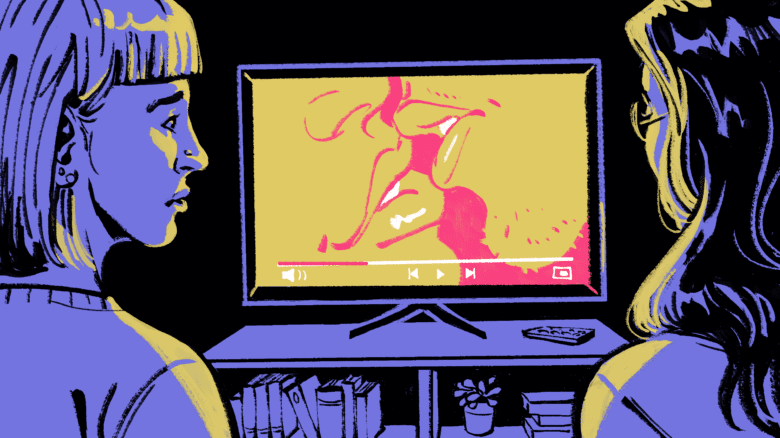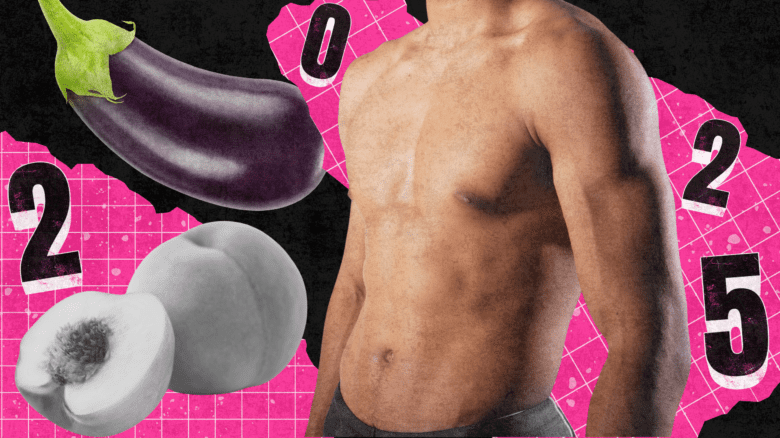Today, I’ll tell anybody who asks that I’m a total lesbian—but that wasn’t always the case. Back in the day, before I transitioned, I was just some dude playing the role of cishet. A big part of my cishet act was “getting girls” which, according to the heteronormative scripts I was following, meant learning to make the first move.
Over time, I got pretty good at it. But when I finally transitioned, I realized I’d just been going through the motions, and there was a radical shift in my sex life. Sapphic intimacy was infinitely more complex and rewarding in ways I hadn’t imagined. There was so much more room for me to communicate and connect, so many more ways to give and receive pleasure—I couldn’t believe I’d been missing out for this long.
The more I talked to my partners, the more it was clear that they were missing out on this connection often, too. All the memes and tropes about endless Sapphic yearning I’d seen online weren’t a joke. People wanted to hook up, but they couldn’t bring themselves to let the objects of their affection know. This was a tragic reality.
“I would say a lot of my [Sapphic] clients are struggling with … how to connect sexually and romantically with other femme-identifying people” says Amelia Sloan, a non-binary psychotherapist specializing in queer sexuality. “For many it’s not even seen as a possibility to have Sapphic desires, so just by nature they default to men.”
This is something I definitely understand. While I identify as a lesbian, I do have sex with men sometimes (don’t @ me), and I’m aware how it is ridiculously easier to arrange.
Factors like compulsory heterosexuality and trauma can block us from directly expressing or pursuing our desires, Sloan says. Breaking through takes intentionality and effort that many haven’t had the chance to learn, especially those just starting to navigate their sexuality.
“I feel like I don’t know how to flirt with women and make that turn into an actual thing,” says Jenn, 24. Jenn is bisexual, and says she’s had plenty of threesomes with cishet couples. But she feels like she’s missing out on intimate connections with other women and non-binary people because insecurity and intimidation often stop her from approaching potential partners.
“I’ll have a friend that I’ll be flirty with, and I really want it to go somewhere, and so may she,” says Jenn. “But it feels like we’re both waiting on a cue for the other person to make that move.”
Sloan says this lack of confidence and miscommunication stems from harmful internalized ideas about queerness and sexual identity.
“One of the biggest reasons is people feeling ‘not queer enough,’ for lack of a better term, to do anything about their desire,” they explain. Meaning even when someone experiences queer attraction, they’ve internalized ways to rationalize or suppress the feelings.
Then there’s the baffling ambiguity of Sapphic flirting itself. I think it’s wild to see the compliments straight women give each other, some of which frankly border on lesbian simping. Femmes I know often express friendship through quality time, physical compliments, even physical touch and I think that’s beautiful. But it can blur the distinction between platonic closeness and sexual interest, especially when they may be present at the same time. For those new to queerness, or who have trouble reading social cues, the anxiety can be especially paralyzing.
“I appreciated that this woman was like, ‘I want to fuck, so let’s fuck.’”
Q Wadoodi, 25, says that over time, she was able to move past this anxiety. Embracing her bisexuality was hard, especially coming from a conservative Muslim background. But today, she says, “I almost feel like it’s easier to flirt with women just because I have more interest in them, and it’s easier to connect with them.”
Wadoodi says that her first lesbian partner’s forwardness helped break the ice with a steamy, spontaneous gym locker room hookup. “She’d always be texting me for quickies; it was just brazen. And I’m not saying that’s ideal [for everybody] … but I appreciated that this woman was like, ‘I want to fuck, so let’s fuck.’”
Wadoodi knows that some of her femme peers avoid this forwardness themselves, out of fear they’ll come across as “predatory” or too forceful. But she blames this holding back on long-standing stereotypes that paint queer and feminine sexuality as inherently deviant.
Still, rationalizing this phenomenon is much easier than overcoming it. I talked to around a dozen queer femmes both on and off the record for this story, and encountered a persistent theme: all of them wished that social norms and stigmas would change so they could feel more comfortable with their desires. But all of them waiting for somebody else to make those changes for them. And not everyone is lucky enough to meet a take-charge dyke like Wadoodi did—nor does everybody want it to happen that way.
“It’s important to build tools for ourselves to feel safe while we navigate these feelings,” explains Sloan. “It’s not a typical script, it’s learning to take risks and maybe receive rejection.”
Personally, I was put through the gauntlet of female rejection early on via the timeless logic of “just ask her out bro, what’s the worst that can happen?” And I can say through experience that this masculine platitude fails to account for things like trauma, rejection-sensitive dysphoria and basic human emotion.
“I don’t ever give advice to just take rejection [repeatedly],” says Sloan. “I don’t think that works.”
Instead, they recommend working slowly and compassionately to help unpack the internal resistance at play in these dynamics.
“How are you blocking yourself from actually getting what you want? And what is that fear?” they ask their clients. These questions take time and reflection to answer, and everybody answers them at their own pace. “(It helps to) pick a safe person to start trying things with, whether that’s a friend or a romantic interest,” says Sloan.
They’re clear this doesn’t have to progress in any linear scripted way, or even lead to sex at all. “Always start with things that feel safe and manageable,” Sloan recommends. Simply cuddling, or making space to communicate desires and insecurities beforehand can build trust and safety that make approaching intimacy far more comfortable.
Once that internal work is done though, being direct is the next step. “You just have to fucking do it,” Wadoodi says. “Say ‘I want to take you out,’ make a lot of eye contact, definitely hand-touching … be flirtatious however you flirt.”
“Waiting for the hero never works,” Sloan agrees. The only way through is to be the take-charge hero dyke you want to see in the world.


 Why you can trust Xtra
Why you can trust Xtra


